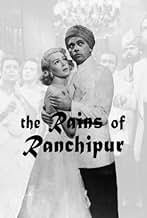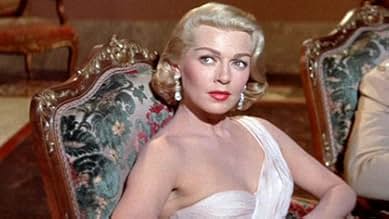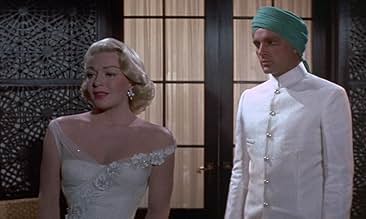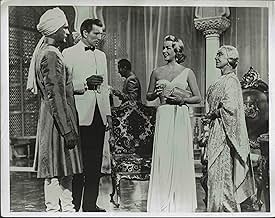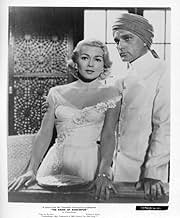VALUTAZIONE IMDb
5,8/10
1204
LA TUA VALUTAZIONE
Aggiungi una trama nella tua linguaDespite marital problems, English Lord Albert Esketh and his rich American socialite wife Lady Edwina Esketh travel to India to buy a prize horse from the ruler of Ranchipur.Despite marital problems, English Lord Albert Esketh and his rich American socialite wife Lady Edwina Esketh travel to India to buy a prize horse from the ruler of Ranchipur.Despite marital problems, English Lord Albert Esketh and his rich American socialite wife Lady Edwina Esketh travel to India to buy a prize horse from the ruler of Ranchipur.
- Regia
- Sceneggiatura
- Star
- Candidato a 1 Oscar
- 1 candidatura in totale
Rama Bai
- Lachmaania
- (non citato nei titoli originali)
John Banner
- Rashid Ali Khan
- (non citato nei titoli originali)
Jugat Bhatia
- Headhunter
- (non citato nei titoli originali)
George Brand
- Mr. Simon
- (non citato nei titoli originali)
Argentina Brunetti
- Mrs. Adoani
- (non citato nei titoli originali)
King Calder
- Mr. Smiley
- (non citato nei titoli originali)
Jack Deery
- Party Guest
- (non citato nei titoli originali)
Paul Frees
- Sundar
- (non citato nei titoli originali)
Recensioni in evidenza
This glamorous remake of the '30s film "And The Rains Came", casts Lana Turner, Richard Burton, and Fred McMurray. Turner is a woman who travels with her husband to India to purchase some horses. While there, the unsatisfied Lana embarks on an affair with Hindu doctor Burton, breaking taboos and causing a ruckus among the elite set. All the drama is compounded by a series of earthquakes and one big flood that threatens the lives of everyone. It's hard to tell what's more beautiful to look at - the Indian scenery(really filmed in Pakistan) or the always elegant Lana. Storyline-wise there's not a lot of substance, but it's truly a visual feast regardless.
The original film on which The Rains Of Ranchipur is a remake, The Rains Came share one thing in common. The Rains Came won the second Oscar given in the category of Best Special Effects and The Rains Of Ranchipur was nominated in the same category. But other than that while the first was a tidal flood of emotions this one barely registers a drizzle.
Unhappily married Michael Rennie and Lana Turner come on holiday to the Indian province of Ranchipur. He married her money, she married his title and she's had a long string of affairs in both hemispheres that always make the gossip columns. She takes one look at Hindu doctor Richard Burton and decides he will be her latest conquest. She also meets another of her former conquests Fred MacMurray who is living out here on his inheritance and who missionary kid Joan Caulfield decides he's got the makings of a reformation project.
That's about how the original film is laid out. But the changes and softenings of the story and the characters make The Rains Of Ranchipur lose all its punch. The biggest changes are to the characters that Lana Turner and Michael Rennie play who were essayed by Myrna Loy and Nigel Bruce in the original. See the two side by side and you'll know what I mean. In addition Joan Caulfield is way too old to be playing college age girls. Her part in the original is done by Brenda Joyce.
Color has been added and some nice location cinematography of India during its first decade of independence is nice to see as well as the earthquake and flooding sequences. It makes up for a watered down story.
Unhappily married Michael Rennie and Lana Turner come on holiday to the Indian province of Ranchipur. He married her money, she married his title and she's had a long string of affairs in both hemispheres that always make the gossip columns. She takes one look at Hindu doctor Richard Burton and decides he will be her latest conquest. She also meets another of her former conquests Fred MacMurray who is living out here on his inheritance and who missionary kid Joan Caulfield decides he's got the makings of a reformation project.
That's about how the original film is laid out. But the changes and softenings of the story and the characters make The Rains Of Ranchipur lose all its punch. The biggest changes are to the characters that Lana Turner and Michael Rennie play who were essayed by Myrna Loy and Nigel Bruce in the original. See the two side by side and you'll know what I mean. In addition Joan Caulfield is way too old to be playing college age girls. Her part in the original is done by Brenda Joyce.
Color has been added and some nice location cinematography of India during its first decade of independence is nice to see as well as the earthquake and flooding sequences. It makes up for a watered down story.
Lord Esketh, a British aristocrat, and his glamorous American wife, Edwina, are touring India and staying in the city of Ranchipur, where they are guests of the local Maharani. (The action is supposed to be set in India, even though we see a prominently displayed Pakistani flag in an early scene). Their marriage is an unhappy one and each despises the other. Edwina despises her husband because she sees him as weak and cowardly and because he only married her for her money. (She is an independently wealthy heiress). He despises her because he sees her as cold and heartless; we learn that she has been unfaithful to him with a number of different men. While in Ranchipur Edwina meets and has an affair with a young suntanned Welshman in a turban.
Well, actually Richard Burton's character is supposed to be an Indian, Dr Safti, a physician and the adopted son of the Maharani. Today, the idea of a white actor in "brownface" playing an Indian would strike most people as politically incorrect, but was an accepted practice in the fifties, and at least Burton's performance is a lot less insensitive than that given by Peter Sellers in "The Millionairess" from a few years later. (Sellers was also playing an Indian doctor). Watching the film, I wondered if the use of the Christian name "Edwina" was a veiled reference to Edwina Mountbatten, another independently wealthy heiress, married to a British aristocrat, who visited India and was rumoured to have had an affair with an Indian man, in her case the politician Jawaharlal Nehru. I understand, however, that "The Rains of Ranchipur" is a remake of "The Rains Came" from 1939 (which I have never seen), and that the character had the same name both in this film and in the 1937 novel on which it was based. As the Mountbattens did not come to India until 1947, the coincidence was presumably unintentional.
The Edwina-Safti romance is the mainspring of the plot, but for all Edwina's good looks she is so obviously spoilt, selfish and promiscuous that it is difficult to imagine any man, let alone one as intelligent and idealistic as Dr Safti, falling hopelessly in love with her. There is a subplot involving another romance between Tom Ransome, an alcoholic former lover of Edwina and close friend of Safti, and Fern, the daughter of a local missionary, but this arouses little interest.
The acting is generally undistinguished. Burton, as though embarrassed by having been cast in a role to which he was ill-suited, is horribly stilted and wooden, giving by far his worst performance in any film of his which I have seen. The Russian-born Eugenie Leontovich as the Maharani is no more convincing as an Indian than is Burton. Lana Turner as Edwina and Fred MacMurray as Tom were both capable of much better things than this. Probably the best is Joan Caulfield as Fern. The intention seems to have been to contrast Fern's youth and innocence with the cynicism and corruption of the experienced older woman Edwina, so it is perhaps surprising that Caulfield, who at 33 was only a year younger than Turner, was cast in the role, but she is fresh and youthful-looking enough to succeed in making the contrast an effective one.
The best thing about the film is its special effects. Although "The Rains of Ranchipur" is not a "disaster movie" in the sense that the film-makers of the seventies would have understood the term, an earthquake and the subsequent flood after the earthquake destroys a dam play important roles in the story. These scenes are very well done, are still convincingly impressive even in the era of CGI and the main reason why I have given the film an average mark. Unfortunately, there is little else to make the film worth watching today. Special effects apart, it is the sort of dull, turgid and implausible melodrama which typified Hollywood at its worst during the fifties. 5/10
Well, actually Richard Burton's character is supposed to be an Indian, Dr Safti, a physician and the adopted son of the Maharani. Today, the idea of a white actor in "brownface" playing an Indian would strike most people as politically incorrect, but was an accepted practice in the fifties, and at least Burton's performance is a lot less insensitive than that given by Peter Sellers in "The Millionairess" from a few years later. (Sellers was also playing an Indian doctor). Watching the film, I wondered if the use of the Christian name "Edwina" was a veiled reference to Edwina Mountbatten, another independently wealthy heiress, married to a British aristocrat, who visited India and was rumoured to have had an affair with an Indian man, in her case the politician Jawaharlal Nehru. I understand, however, that "The Rains of Ranchipur" is a remake of "The Rains Came" from 1939 (which I have never seen), and that the character had the same name both in this film and in the 1937 novel on which it was based. As the Mountbattens did not come to India until 1947, the coincidence was presumably unintentional.
The Edwina-Safti romance is the mainspring of the plot, but for all Edwina's good looks she is so obviously spoilt, selfish and promiscuous that it is difficult to imagine any man, let alone one as intelligent and idealistic as Dr Safti, falling hopelessly in love with her. There is a subplot involving another romance between Tom Ransome, an alcoholic former lover of Edwina and close friend of Safti, and Fern, the daughter of a local missionary, but this arouses little interest.
The acting is generally undistinguished. Burton, as though embarrassed by having been cast in a role to which he was ill-suited, is horribly stilted and wooden, giving by far his worst performance in any film of his which I have seen. The Russian-born Eugenie Leontovich as the Maharani is no more convincing as an Indian than is Burton. Lana Turner as Edwina and Fred MacMurray as Tom were both capable of much better things than this. Probably the best is Joan Caulfield as Fern. The intention seems to have been to contrast Fern's youth and innocence with the cynicism and corruption of the experienced older woman Edwina, so it is perhaps surprising that Caulfield, who at 33 was only a year younger than Turner, was cast in the role, but she is fresh and youthful-looking enough to succeed in making the contrast an effective one.
The best thing about the film is its special effects. Although "The Rains of Ranchipur" is not a "disaster movie" in the sense that the film-makers of the seventies would have understood the term, an earthquake and the subsequent flood after the earthquake destroys a dam play important roles in the story. These scenes are very well done, are still convincingly impressive even in the era of CGI and the main reason why I have given the film an average mark. Unfortunately, there is little else to make the film worth watching today. Special effects apart, it is the sort of dull, turgid and implausible melodrama which typified Hollywood at its worst during the fifties. 5/10
I was halfway through this movie before realizing I'd seen it before. Only, I remembered it filmed in black and white, with Myrna Loy as the star, instead of Lana Turner in Technicolor. The Rains of Ranchipur is a remake of the 1939 disaster drama The Rains Came. In both movies, a married hussy seduces an Indian doctor while living in Ranchipur. Her attentions become a blot on his impeccable reputation, and she has nothing more than her own interests at heart.
At first, I thought the remake would be an improvement. Myrna Loy was never known for her seductive prowess, but that type of behavior was second nature to Lana Turner, so I thought the steamy scenes would be steamier. Also, Tyrone Power played the Indian doctor in the original, rather than an ethnically appropriate actor, so I hoped the remake would make a better casting choice. No and no. Even though Myrna isn't the sexiest actress out there, her chemistry with Tyrone was infinitely more sizzling than Lana's was with Richard Burton. Wait, Richard Burton played the Indian doctor? I'm sorry to have to tell you that yes, he did, and with nothing more than a plain turban wrapped around his head as indication that he's racially different than his love interest. The two stars, who are very capable of creating sexual tension on the screen, must have hated each other during the filming. The chemistry was nonexistent.
I'll try not to spoil anything, but this plot point is in the title: a monsoon rains down on Ranchipur. Believe it or not, the big disaster scene is scarier, more effective, and had better special effects in 1939 than in 1955! The costumes were also quite elegant and regal in the original version. Myrna was dressed in beautiful ball gowns, and Tyrone had resplendent outfits. Richard Burton was very plainly clad, and Lana Turner's dresses actually made her look like she had a bad figure.
All in all, the remake was a big disappointment. Watch The Rains Came instead. It's dramatic, sexy, and exciting—I don't know how the monsoon scene was filmed in 1939!
At first, I thought the remake would be an improvement. Myrna Loy was never known for her seductive prowess, but that type of behavior was second nature to Lana Turner, so I thought the steamy scenes would be steamier. Also, Tyrone Power played the Indian doctor in the original, rather than an ethnically appropriate actor, so I hoped the remake would make a better casting choice. No and no. Even though Myrna isn't the sexiest actress out there, her chemistry with Tyrone was infinitely more sizzling than Lana's was with Richard Burton. Wait, Richard Burton played the Indian doctor? I'm sorry to have to tell you that yes, he did, and with nothing more than a plain turban wrapped around his head as indication that he's racially different than his love interest. The two stars, who are very capable of creating sexual tension on the screen, must have hated each other during the filming. The chemistry was nonexistent.
I'll try not to spoil anything, but this plot point is in the title: a monsoon rains down on Ranchipur. Believe it or not, the big disaster scene is scarier, more effective, and had better special effects in 1939 than in 1955! The costumes were also quite elegant and regal in the original version. Myrna was dressed in beautiful ball gowns, and Tyrone had resplendent outfits. Richard Burton was very plainly clad, and Lana Turner's dresses actually made her look like she had a bad figure.
All in all, the remake was a big disappointment. Watch The Rains Came instead. It's dramatic, sexy, and exciting—I don't know how the monsoon scene was filmed in 1939!
This wide-screen romance yarn showcases the lovely Lana Turner as a wealthy and restless socialite who becomes smitten with a handsome native doctor during a trip to India. This is the main thread of the film although there are other sub-plots at work here. Richard Burton is good as the object of Turner's affections and Eugenie Leontovich is regal as the Maharani who raised Burton from childhood. This sage queen watches the blossoming romance with cold displeasure, deeply jealous of Turner's hold on him. Fred MacMurray is involved in another clincher with Joan Caulfield that doesn't ring true and adds very little to the main story. Michael Rennie has a thankless role as Turner's husband, whom she keeps at arms's length throughout the movie. The ensuing monsoons, flooding and earthquake in the region are awesome and terrible in their destruction, the special effects of which are very good. Turner is clothed in a first-class wardrobe and the film's sets reflect the lavish production. Milton Krasner's camera and Hugo Friedhofer's exotic music score are first-rate.
Lo sapevi?
- QuizLe pioggie di Ranchipur (1955) was originally to be shot on location in both India and Pakistan. Modern sources claim that India refused to grant the studio a filming permit, however, and contemporary sources reported that backgrounds for the picture were shot on location in Pakistan only. Some location shooting was also done on the Twentieth Century-Fox ranch in Malibu, CA. Principal players never left Hollywood. Doubles filled in for the main cast in the long shots and whatever other scenes that were needed.
- ConnessioniEdited into Il nostro agente Flint (1966)
I più visti
Accedi per valutare e creare un elenco di titoli salvati per ottenere consigli personalizzati
- How long is The Rains of Ranchipur?Powered by Alexa
Dettagli
Botteghino
- Budget
- 4.500.000 USD (previsto)
- Tempo di esecuzione
- 1h 44min(104 min)
- Proporzioni
- 2.55 : 1
Contribuisci a questa pagina
Suggerisci una modifica o aggiungi i contenuti mancanti

